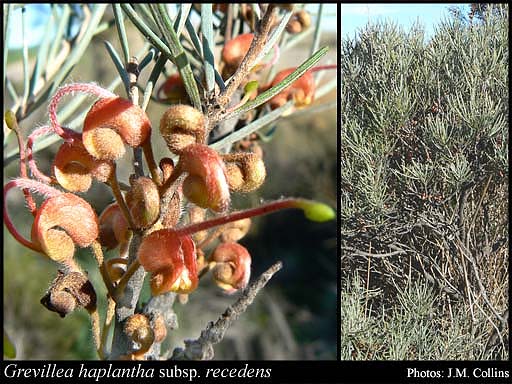- Reference
- Nuytsia 9(2):290, Fig.17 (1993)
- Conservation Code
- Priority Three
- Naturalised Status
- Native to Western Australia
- Name Status
- Current
Erect or spreading shrub, 0.6-1 m high. Fl. red, Jun to Aug. Sand, sandy loam.

Scientific Description
Shrubs, 0.5-1 m high; branchlets hairy, not glaucous. Leaves alternate, 20-85 mm long, 1.5-2 mm wide, hairy or glabrous, on the adaxial or abaxial surface, the hairs straight; lamina flat, more or less the same width throughout, entire, the margins revolute, enclosing the lower surface of the leaf blade, forming a groove either side of the midvein. Inflorescences axillary or cauline, red or pink; pedicels 4-6 mm long. Perianth 7-9 mm long; tepals some joined and some free after flower opens, hairy, simple-hairy; ovary hairy, stipitate, the stipe 0.5-1 mm long; pistil 18-20 mm long, red, pollen presenter lateral, style hairy or glabrous. Follicles hairy, not viscid, dehiscent, 10-13 mm long. Flowers in June, July, August or September. Occurs in the South-west (SW) Botanical Province(s), in the Avon Wheatbelt (AW) IBRA subregion(s). : Conservation code Priority Three (P3).
Distribution
- IBRA Regions
- Avon Wheatbelt.
- IBRA Subregions
- Katanning, Merredin.
- Local Government Areas (LGAs)
- Bruce Rock, Cunderdin, Dowerin, Koorda, Merredin, Moora, Tammin, Trayning, Wongan-Ballidu, Wyalkatchem.